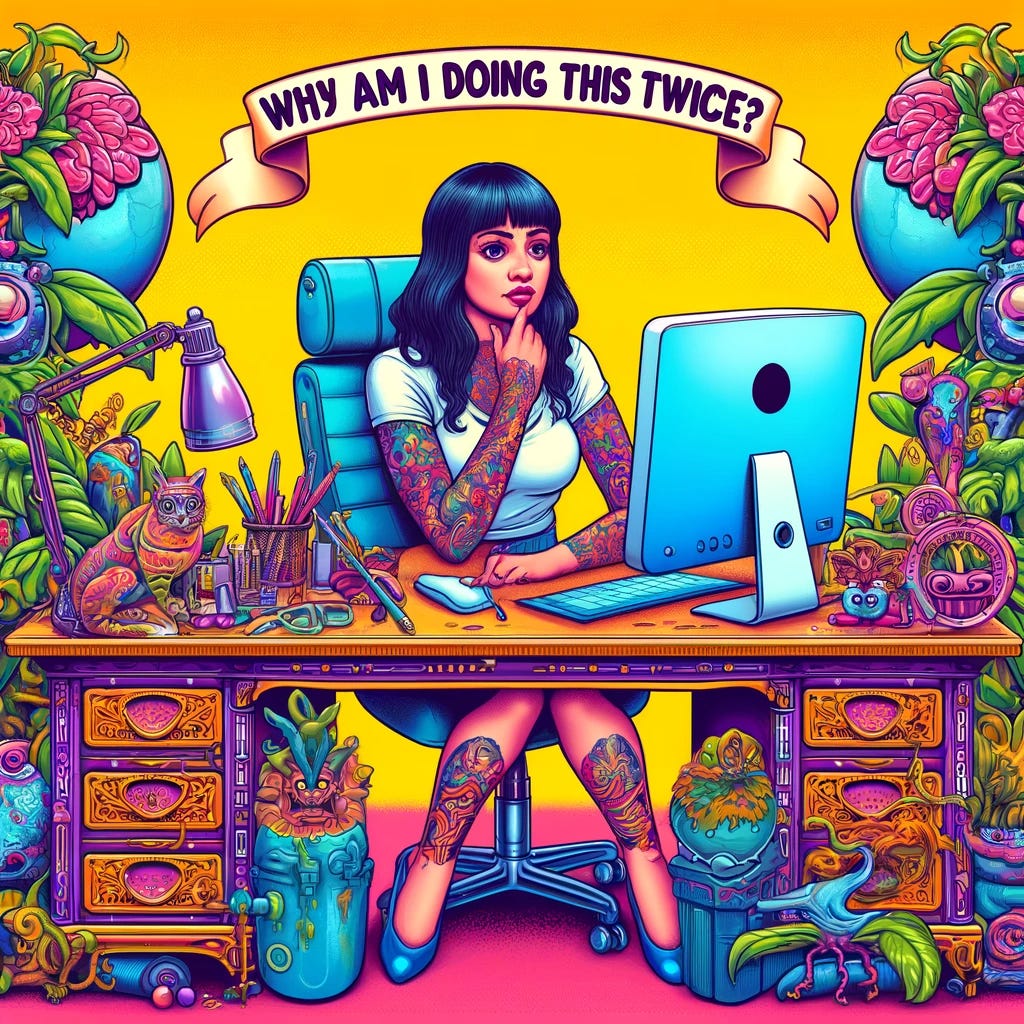Want to FINALLY build a daily writing habit?
We spent the last 3 months upgrading Ship 30 to make it better than ever before. It's designed to help you: build an audience, become a prolific writer, and accelerate your writing career.
Click here to join Ship 30 for 30 today
We hope to see you on the other side.
Hey there, Digital Writers!
One of the most important things you can do as a writer, creator, or “curious learner” is to crystalize and leverage frameworks.
This is how you get the most benefit out of anything you learn.
It's one thing to take a course and go, "Okay, I just learned seven new frameworks", but it's another to take those frameworks and find a way to use and reuse them over and over again without having to constantly reinvent the wheel.
Which is why learning how to write AI prompts is so valuable.
Let me explain.
The Prompt Creator’s Barbell
As you go through courses, read books, join masterminds, whatever your method is for learning, you want to figure out:
What's sticking with you
What frameworks you're extracting
What you’ve written down in your notes thinking, "Oh man, this is really cool. I need to remember how to do this.."
And then for each of those things that you extract, ask yourself, "Okay, so how do I create a prompt out of this so I can leverage it on demand?"
Curating frameworks and turning them into a reusable prompt is one side of the barbell.The other side of the barbell is if you're not learning the framework and turning it into a prompt, you're basically taking something in your life, in your career, something that you're doing over and over again, and you're reverse engineering the steps.
For example:
Let's say you're a content creator who writes a weekly email newsletter. Every week, you go through the same process: brainstorming topics, researching, outlining, drafting, editing, and finally sending the newsletter. If you break down each of these steps, there are certain parts of the process that are repetitive and could be streamlined with AI.
In the research phase, you could create a prompt that asks the AI to find relevant statistics, case studies, and examples based on your newsletter topic.
For the outlining phase, you could prompt the AI to generate a potential outline based on your main talking points.
By identifying these repetitive tasks and creating prompts to help automate or streamline them, you can save yourself hours of work each week and focus on the parts of the newsletter writing process that truly require your human creativity and insight.
For more on this method, take a look at how we did this for The Tequila Test in How To Create Frameworks From Scratch.
The "Why Am I Doing This Twice?" Rule of Thumb
A good rule of thumb is anytime you do something twice, ask yourself 3 questions:
Why am I the one doing this?
Do I need to be the one doing this?
If not, can I hire someone do this for me?
This applies to everything in life—even taking out the trash.
I guarantee there are things in your life where if you ask these questions you’ll realize, "Wait, I might not be the one who needs to do this."
And in the past, the answer would have been "I need to go hire someone."
But now the answer is “Maybe I don't need to be the one to do this.”
Can I train my AI assistant to do it?
That's a really powerful question.
So rule of thumb, anytime you find yourself doing something twice, ask yourself why you're the one still doing it. Sometimes you might have to be the one to keep doing it, but other times you can train the AI.
The CEO For A Day Technique
Now, here's the simple technique I want to share with you if you're struggling to figure out how to write a prompt.
Our Write With AI prompts are long. They are like mini instruction manuals. Which is a great way to think about what a prompt really is.
Put on your CEO hat.
Pretend you hire an intern for the day. You have to get that intern to go do a task for you. You have two options:
You can either sit there and try and write out here's everything I want you to do step-by-step in a guide for them.
Or you can speak to them and help them take notes.
Both work and both are different skills.
Our WWAI prompts are the written version of the instructions. They are long because here’s how we think, "I’m gonna sit here and write out the instruction manual to write this newsletter. And then I’m going to hand it to my AI digital writing assistant and they're gonna execute on it." Scan through the 100+ prompts we’ve created in the last year and you’ll notice that every single one of our Ship 30 for 30 Digital Writing frameworks has been…say it with me now…turned into a prompt!
See how this works?
Now, if you're struggling with the writing process or trying to figure out how to explain a framework, there’s a different way to approach this.
Take out your phone.
Voice record yourself talking as if you are talking to an intern.
How To Write Prompts With Your Voice
Imagine you hired an intern and you're gonna train them on how you write your weekly newsletter, or how you write your short form social posts, or how you come up with YouTube scripts.
Record a voice memo of you explaining how you do what you do. And then upload the recording to a platform like Descript, and transcribe it into text. Or you can use Otter.ai right on your phone, dictate the framework, and Otter will live transcribe it for you.
Check out How To Create The Perfect LinkedIn Post Without Typing to see this method in action.
I’ve found this technique to be extremely effective for people who are struggling with the writing in the beginning. Writing is always a reflection of clarity of thought. So, if you're having a hard time writing out a framework, that means that you're having a hard time thinking through it.
You don't really know what you're trying to say—yet.
And instead of throwing your hands in the air and going "I can't do this, I'm giving up", a much easier technique is to record yourself and think through it out loud. Then you can go back through the transcription, put it into a doc and remove all the tangents, remove all the things where you were still trying to figure out what you're saying and just keep the meat of it.
Clean it up and turn it into a prompt!
Easy.
When it comes to creating prompts with AI, the hard part is not the writing.
The writing is very easy. All you're doing is giving instructions to AI. It's not about getting it perfect. It's not about writing something that's good. The point and the skill of writing prompts is getting clear on what you're trying to say.
It's all clarity of thought.
Talk to your phone. Get through the thinking process first. And then it'll be easy for you to translate into a prompt.
That’s it.
Happy prompting!
Co-Creators of Ship 30 for 30.







If you are doing anything twice or more than twice, make it a function. But you not need to be a software developer or an engineer to write the function. You can follow "Rule of Thumb".
OR
The "Why Am I Doing This Twice?" Rule of Thumb